In a nutshell, the MLS article notes that Philomathea Club (Greek for "love of learning") club was formed at the home of Captain Stiles in October 1889 by the wives of leading city merchants, and the group set out to improve culture and education in the rough and rowdy town born 5-6 months earlier. The group's efforts led to the city's first public library in 1898, initially located in the Farmers National Bank at the southwest corner of Grand (Sheridan) and Robinson.
But, with only a room or maybe two, much more was obviously needed. Oklahoma City merchant Thomas P. Mellon (son of financier Andrew Mellon) suggested that the group write his father's associate, Andrew Carnegie, for a $25,000 grant. The article notes that by 1896, Carnegie accepted solicitations for libraries all across the United States and that by 1923 he had helped fund 1,681 libraries in 1,412 towns. Oklahoma City was one of them. In 1900, the cornerstone for Oklahoma City's Carnegie Library was laid at the northwest corner of NW 3rd and Robinson and it opened in 1901.

From Vanished Splendor (I) by Jim Edwards and Hal Ottaway (Abalache Book Shop Publishing Co. 1982)

Some actual photos of the Carnegie Library are at the Metropolitan Library Website (again, you may have to press your F5 key after clicking the link for the target page to open).
Who could use the library? A December 10, 1905, Oklahoman article reported that, "All residents of the city, or persons having employment therein, are entitled to use the library on signing an obligation to observe the rules and regulations made for the government of the library, which obligation must be signed by one taxpayer who is not a member of the family of the applicant."
Whether that was code-talk for a racially segregated policy, or whether this library was segregated or not, I've not been able to determine. However, consider the text in Jim Edwards, Mitchell Oliphant, and Hal Ottaways', Vanished Splendor III (Abalache Book Shop Publishing Co. 1985), associated with the pic below of the Dunbar Library (the image follows the text):
The Dunbar Branch Library, at 613 Northeast 4th, was opened on July 11, 1926. In the days of segregation, this was Oklahoma City's library for black people.
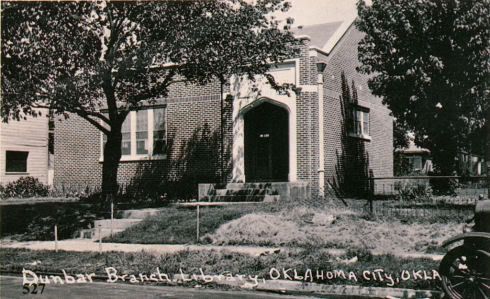
The address on NE 4th places the Dunbar Library at approximately NE 4th & Lincoln Blvd., about 9 blocks from the Carnegie Library.
The Oklahoman's archives reflect that the initial Carnegie facility quickly became too small and that negotiations occurred in 1907 to sell the property to become the home of the Elks Lodge. Instead, another request was made of Mr. Carnegie for $25,000. An April 14, 1907, Oklahoman article reported that Mr. Carnegie would make an additional $25,000 grant to construction a library addition which would double its space. The article said that Dr. J. Hensley, member of the library board, received the notification letter. But, in an August 2, 1907, article, it was reported that, since Mayor Scales did not appoint Dr. Hensley to succeed himself as a member of the library board, Dr. Hensley threatened "to make every effort" to prevent Oklahoma City from securing immediate benefits from the $25,000 gift! Apparently feeling slighted, Dr. Hensley said, "I will block any move the board may make, with an injunction and will then take the matter up with Mr. Carnegie." The article also said, "Work on the library has already been delayed several months on account of the attitude of Dr. Hensley."
Apparently Dr. Hensley was allied with architect and city councilman G.W. VanMeter – VanMeter's plans had been sent to Mr. Carnegie – but with Hensley's non-reappointment, he wrote to Carnegie offering his opinion that the benefactor would be "wise to withdraw the donation." At least, that's the report in the September 5, 1908, Oklahoman, below. The article notes that Van Meter and another had also corresponded with Carnegie's treasurer the result being that even though the $25,000 grant had earlier been made a "hold" had been placed on it but that fact had not been communicated to the city, even though contracts had apparently been let which obligated the city. When Mayor Scales notified the Carnegie organization that the city was about to write a $5,000 draft on the account, he first learned of the "hold" and the article says that, "This came as a thunderbolt to Mayor Scales and the library board."
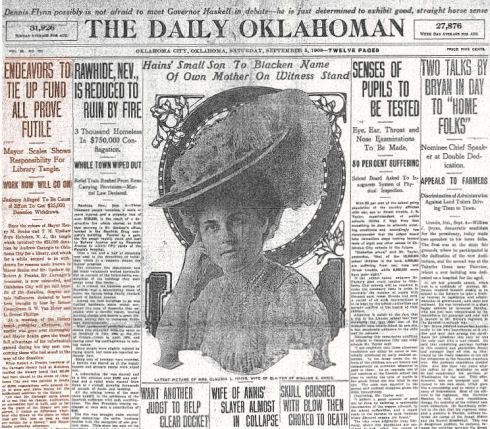
The article reports that Mayor Scales traveled to Hoboken, New Jersey, and in meetings with Carnegie's treasurer, Robert Franks, the nasty correspondence by Hensley, VanMeter, and another, was revealed to him! After meetings, the article says,
"Mr. Franks is a most affable gentleman and gave me a patient hearing, appearing quite anxious to learn all about the affair," said Mayor Scales. "When I had finished he was much chagrined and said that he was surprised to learn that in Oklahoma City, a city of 50,000 people, that there should be such citizens who would put their city in a position so embarrassing," said Mayor Scales.A July 22, 1909, article reported that the expansion had been completed, saying, "The improvements were made possible by the gift of $35,000 from Andrew Carnegie," so it sounds like more was given than was planned in 1907. A June 12, 1910, Oklahoman article said that the library had grown to become one of the largest "in this part of the country, and exceeds any in the state, both in size and in number of volumes."
The Successor Downtown Library. The Metropolitan Library System article notes that, "In 1945, the Friends of the Library association was formed, largely because citizens had become concerned that a library built to serve 10,000 people could not adequately serve 250,000 as it was now expected to do. The Friends quickly pooled public support and were able to secure a $500,000 bond to provide for the construction of a new main library. * * * The new main library was built on the site of the old one and was opened in 1954." In other words, the Carnegie Library was demolished and the new facility was built in the same space.
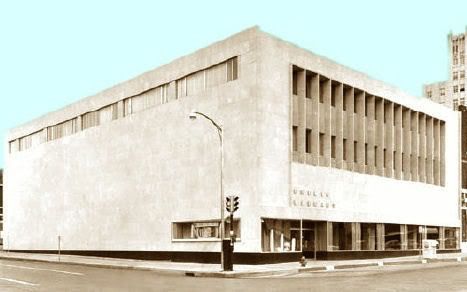
Actually, a July 12, 1953, Oklahoman article shows that the new library was partially opened for business in 1953 with the 1st floor and basement opened, even though it was not formally "dedicated" until Sunday, January 10, 1954. The July 1953 article describes the $600,000 library as "ultra-modern," saying that the new facility was "believed to be the first in the nation to offer drive-up service.

As it developed over time, in addition to having a parking problem at the busy location, the 1953-54 library would come to be too small, also. Plans were made to build a high-tech facility, perhaps near the Myriad Gardens, but they got nowhere fast. Mayor Andy Coats' 1986 "Six To Fix" proposal included separate specific tax/bond proposals, one of which would have funded a new library, but the library proposal failed.
An April 13, 1988, Oklahoman article speculated about the possibility of having a new library in place by Oklahoma City's 1989 Centennial but described that as a "long shot," as it was since that didn't happen. The new library would have to wait for M.A.P.S.
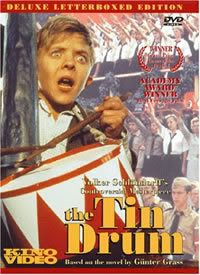 The Tin Drum Affair. During the Downtown Library's tenure at NW 3rd (McGee) and Robinson, one of the city's most embarrassing moments involved what I'll call, "The Tin Drum Affair." A foreboding omen appeared in a November 12, 1980, Oklahoman article which reported that the director of the American Library Association's Office for Intellectual Freedom opined that America's public libraries "are facing a massive new wave of censorship in the wake of last week's conservative election victories." Locally, a February 23, 1966, Oklahoman article reported that the latest "extension" of book banning at Northwest Classen High School by Principal J. Frank Malone included Shakespeare's Romeo and Juliet and Nathaniel Hawthorne's The Scarlet Letter. Already on the banned list was J.D. Salinger's Catcher in the Rye. The article reported an unhappy mom as saying, "Now he's banning Shakespeare ... what's next?"
The Tin Drum Affair. During the Downtown Library's tenure at NW 3rd (McGee) and Robinson, one of the city's most embarrassing moments involved what I'll call, "The Tin Drum Affair." A foreboding omen appeared in a November 12, 1980, Oklahoman article which reported that the director of the American Library Association's Office for Intellectual Freedom opined that America's public libraries "are facing a massive new wave of censorship in the wake of last week's conservative election victories." Locally, a February 23, 1966, Oklahoman article reported that the latest "extension" of book banning at Northwest Classen High School by Principal J. Frank Malone included Shakespeare's Romeo and Juliet and Nathaniel Hawthorne's The Scarlet Letter. Already on the banned list was J.D. Salinger's Catcher in the Rye. The article reported an unhappy mom as saying, "Now he's banning Shakespeare ... what's next?"Fast forward to 1997. In this year, a group calling itself "Oklahomans For Children and Families," a self-appointed anti-pornography group, persuaded all members of the City Council except Mark Schwartz, Ann Simank, and Willa Johnson (to their credit) to support a resolution directed to the Metropolitan Library System, requesting that it reconsider policies to "segregate" certain materials so that only adults could view them or check them out. Included by the group were those intended for children for purposes of sex education. Instead, the director of the Metropolitan Library System, Lee Brawner, opposed the resolution, he preferring a policy that would give parents the option of signing a permission form before a child could get a library card. See Jack Money's March 28, 1997, Oklahoman article for more. The article reports Council member Frosty Peak, the resolution's sponsor, as saying, "This resolution is hardly censorship, or wanting censorship." (Doug Dawgz once-high impressions of Frosty Peak have suffered after reading this article.) More, the OCAF wanted the Library's director, Lee Brawner, and every other member of the library board, to be fired, according to a June 25, 1997, Oklahoman article.
Maybe the above wasn't censorship, but in December 31, 1997, an Oklahoman article reported that Dateline NBC was about to air a segment on what occurred in Oklahoma City during June 1997 and during the months which followed, and in which The Tin Drum Affair would be splashed across TV screens all around the country. Oklahoma City received international scorn, as well.
One of the newscasters at KFOR-TV sometimes says, "Is this a great state, or what?" In this time, the answer would have to be, "or what!" These were dark days for Oklahoma City, in Doug Dawgz opinion. The whole nation and world got to see Okc's dark side, in large part thanks to the OCAF organization.
In June, Oklahoma County District Judge Richard Freeman, at the instance of the "Oklahomans For Children and Families" organization (who had apparently not seen the movie), authorized law enforcement officials to confiscate copies of the award winning movie, The Tin Drum, including the single copy owned by the Metropolitan Library System, and including copies from the homes of citizens who had the movie rented from Blockbuster, et al. The only copy that the Metropolitan Library System had was already checked out by a member of the OCAF organization who, in turn, delivered it to the police, it being the good citizen that the group professed to be.
One who had rented the movie was Michael Camfield ... he was watching the movie in his home when Oklahoma City Police knocked on his door and demanded confiscation of the video. Camfield was a member of the ACLU and that intrusive action didn't set will with him ... as it didn't with many many other Oklahoma Citians. It is good to recall the 1966 mom's query, above, "Now he's banning Shakespeare ... what's next?" Maybe not the "next," but this sad episode will serve to tell the tale.
German author Guenter Grass won the Nobel Prize for his 1959 book in September 1999. The movie version won an Academy Award for Best Foreign Film in 1978. Ensuing Federal Court litigation in Oklahoma City resulted in judgment against then District Attorney Bob Macy and the City which, before all was done, resulted in City liability exceeding $700,000. Federal (and Republican) District Judge Ralph Thompson ruled that the film was not "obscene" and that federal privacy laws had been violated. An October 21, 1998, Oklahoman article said that Thompson's 11 page order said that the decision "was a victory for the Oklahoma County Metropolitan Library System."
The article quoted Lee Brawner as saying that the Library's single copy would be put back into immediate circulation, he adding, "And, we will be ordering many additional copies – with great delight. We will be making available a film to our patrons that they never should have been denied the right to access." The same article quotes Michael Salem, a Norman lawyer who does volunteer work for the ACLU, as saying that he hopes the ruling will restore the First Amendment to Oklahoma County. "This is a case for people who would put fig leaves on Michelangelo's statue of David."
As said above, the liability of the City for judgments and legal fees came to exceed $700,000. In other words, the message to Oklahoma City property taxpayers was, "Pay the bill."
And what was the liability of the self-righteous OCAF? None at all, said its Executive Director Bob Anderson. According to a March 16, 1999, Oklahoman article, he said, "OCAF was merely a messenger to law enforcement authorities, as we have been since 1984." Some messenger!
The OCAF had no responsibility for its actions associated with The Tin Drum Affair. Doug Dawg says, "You guys promote and advocate your policies, as you say as "messengers," but that advocacy which causes city taxpayers to have to foot the bill for your idiotic notions and then you wash your hands of responsibility like Pontius Pilate did ... these guys who are steeped in their Bible background will certainly know what I mean. But, puhleeze ... gimmie a historical Bible break!
Should this group surface again to tell "Oklahoma City what it really needs to know," avoid any such advice as you would a plague of locusts in the "Biblical sense." Either that, or be prepared to pay the bill for what they may persuade you to do, and, then, without any liability for your choice in doing so. They won't help you pay the freight ... only you and other Oklahoma Citians will have that burden.
M.A.P.S. and the New Library. Although Oklahoma City's form of municipal government is not the "strong mayor" model, Oklahoma City surely had a "model strong mayor" in Ronald J. Norick. Doug Dawg is 100% convinced but for his boldness, savvy, cajoling, and persistence – which is to say, his leadership – downtown Oklahoma City and the city, generally, would still be in the malaise it suffered through after the "Oil Bust", Penn Square and other bank closings, and a stalled out and incomplete Pei Plan. By passing the initial Metropolitan Area Planning Projects in December 1993, Oklahoma Citians voted to tax themselves with a penny sales tax for 5 years to accomplish this bold plan, all included on an up or down "yes" or "no" vote (unlike Mayor Coats earlier "Six to Fix" proposal which broke down offerings into single proposals). On December 14 following the affirmative vote, Mayor Norick is reported as saying, "Oklahoma City, welcome to the big leagues." But, unless something happened, the tax would end in December 1998, projects would have to be curtailed or not done at all, and the new library and arena were at risk.
On October 28, 1997, Mayor Norick announced that he would not for re-election. On October 29,the Mayor proposed to put to the people a vote to extend the penny sales tax so that the projects could all be completed. According to the October 30, 1997, Oklahoman in an article by Jack Money and Steve Lackmeyer, the mayor is reported as saying, "I wouldn't mind taking the heat on this. It would be my final hurrah." The City Council would need to be persuaded for that to happen. "Absolutely not!" said Frosty Peak, and the article reports that council member Jack Cornett was "equally hesitant." A November 3 article by Lackmeyer & Money predicted and speculated that Mayor Norick's announcement would make for a "Wild Mayoral Race" and, indeed, it did!
Money and Lackmeyer were at it again in reporting the results of a poll, paid for by Mayor Norick. In their November 6 article, they reported that the poll showed support amongst voters to extend the tax and complete the projects "despite delays and increases in building costs." "Norick said he was most surprised by the response to a question about the proposed tax extension. While he thought it might receive a 30 percent approval rating, the poll showed a tax extension would receive a 50 percent approval with 2 percent undecided." The "two guys" (Lackmeyer & Money) were at it again in reporting council member Guy Liebermann's "first shot" of the mayoral race – in their February 3, 1998, article, they reported that he advocated "shelving" the indoor sports arena (do you remember the Hornets? No arena, no Hornets or our next NBA team in Okc!). In March 2, the prolific writers reported that, "MAPS Solutions Become Focus of City's Mayoral Candidates."
To cut to the quick, Kirk Humphreys who ran on a campaign to "Fix Maps Right," won the race (defeating Lieberman in a runoff), and April 14, he was sworn in as the city's new mayor. But, what would come of the MAPS sales tax extension proposed earlier by Mayor Norick?
On December 8, 1998, a 6 month extension of the sales tax would be put to a vote of the people. A Money/Lackmeyer article in the November 22, 1998, Sunday Oklahoman, opined that "MAPS Showed Way Out of Defeat" and in another article on the same day, they said, "MAPS Restored City's Spirit." Hmmm ... it seems to Doug Dawg that these two Oklahoma City cheerleaders with the power of the pen helped shape Oklahoma City's history! What do you think?
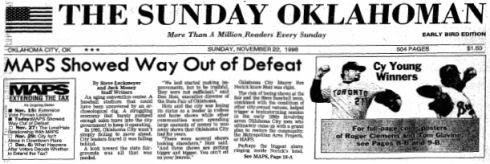
On Wednesday, December 9, the same two guys reported election results on page 1 – 67.67% of voters voted to extend the tax and "Fix Maps Right."
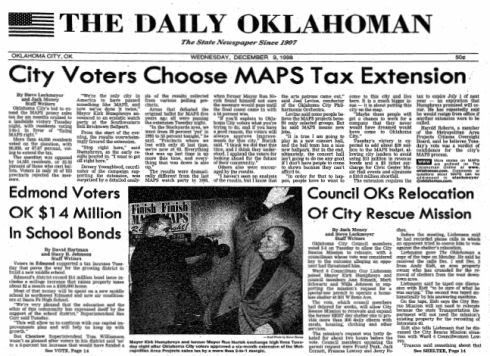
The Ronald J. Norick Library & Learning Center. This magnificent facility is located on Park Avenue between Hudson & Harvey. A December 31, 2003, Oklahoman article announced that, "The City Council had voted to name the new library the "Ronald J. Norick Downtown Library. The vote was followed by a lengthy standing ovation from those in the council chambers." According to the report, "Ward 1 Councilman Mick Cornett brought the proposal before the council to name the library. Cornett said Norick risked his political career on the ambitious plan." Later, in an April 25, 2004, article, Steve Lackmeyer quoted then Mayor Mick Cornett as saying, "MAPS has changed Oklahoma City forever." And, so says Doug Dawg, as well. The new downtown library opened on August 17, 2004.
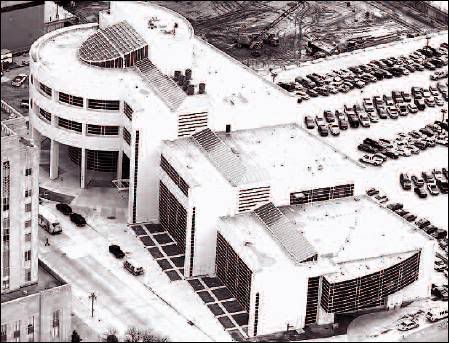
And, with this very long introduction, here are the pics I took on my visit to the downtown Norick Library on Saturday, July 28, 2007, which featured the library's new "First Edition Café." Click any image for a larger view.

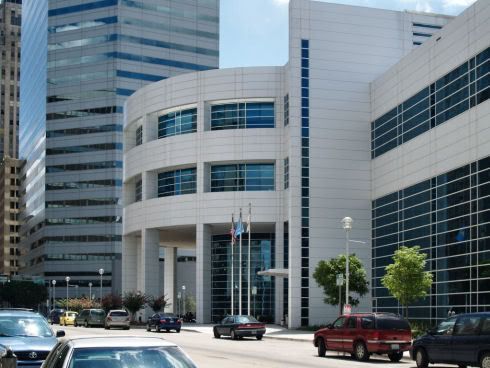
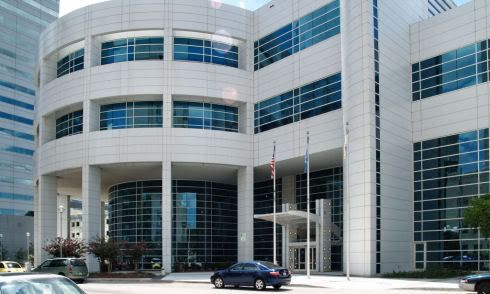
Looking Southwest From Harvey
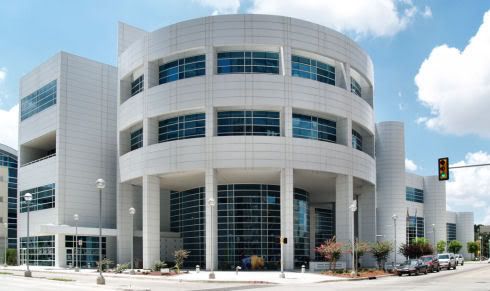
Looking South on Harvey to Central Parking
First Edition Café entrance is on East Side of Library

Bust of Mayor Norick on 1st Floor
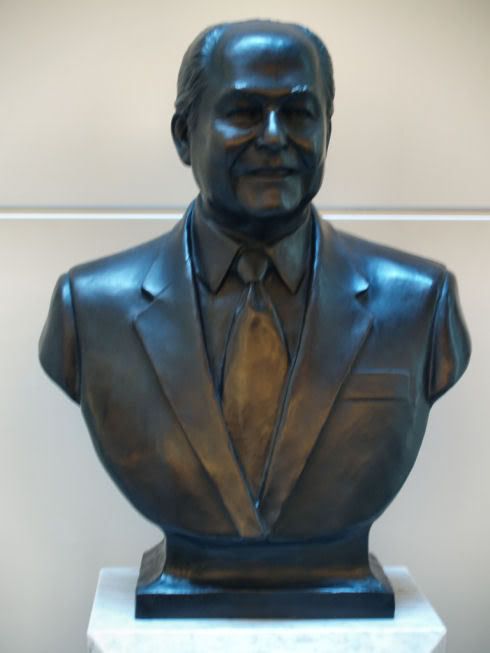
Inside The Café Looking East To Oklahoma Tower

Inside The Café Looking Up and South
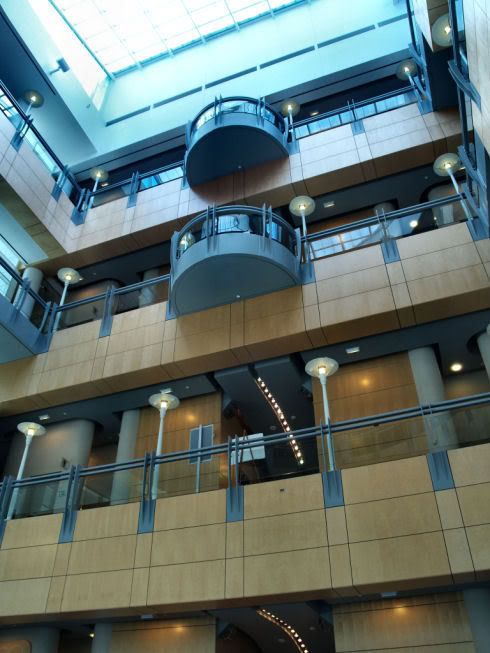
Inside The Café Looking Up and Around
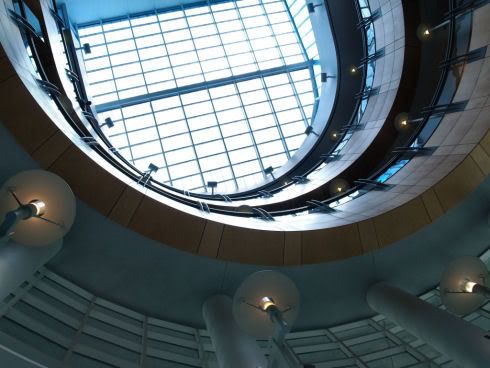
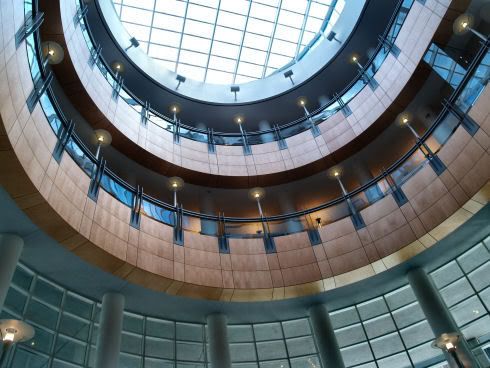

On Fist Floor Looking West
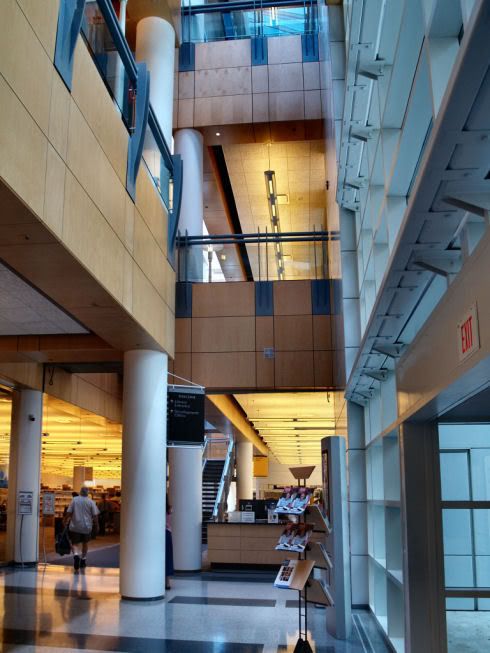
On Second Floor Looking Up
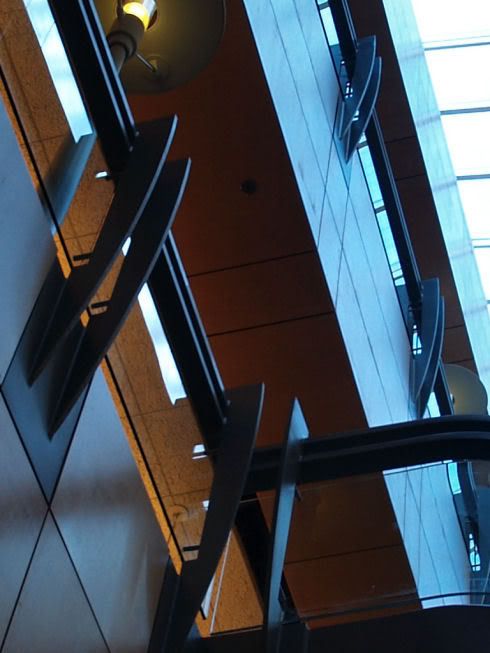
On Second Floor Looking Southwest Into Reading Room
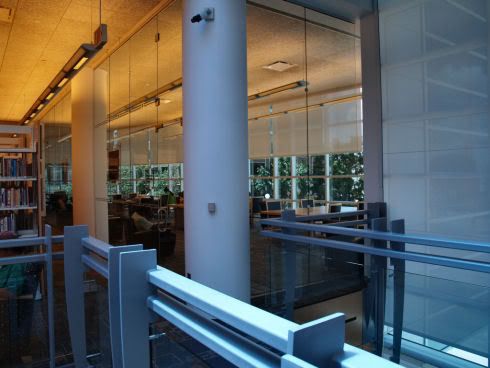
On Second Floor Looking At The Oklahoma Room
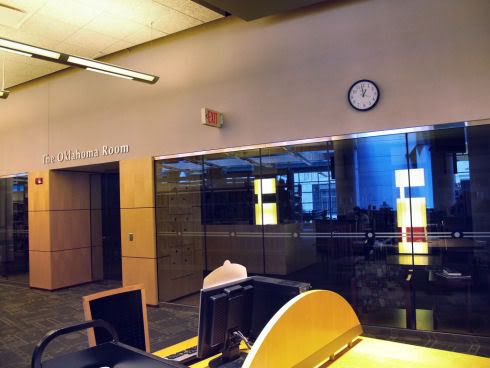

On Fourth Floor Looking West
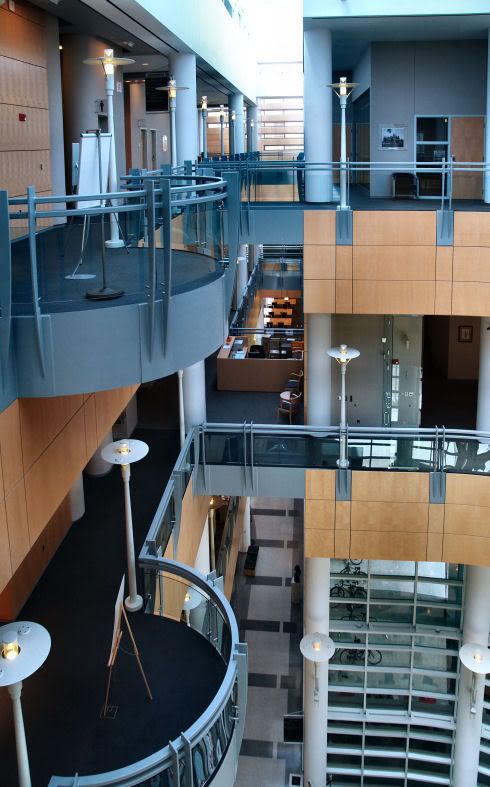
On Fourth Floor Looking Down At The Café
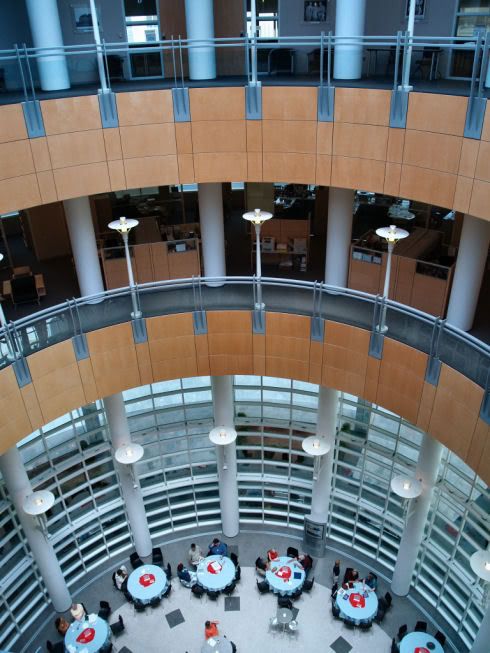
Say ... Who Are Those Guys In The Middle?

Yep. It's The Two Guys Who Helped Shape Okc History,
Steve Lackmeyer & Jack Money!
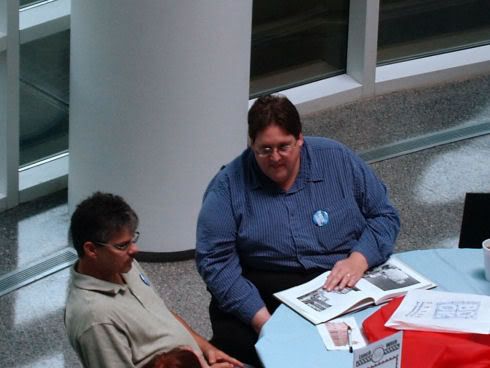
There you have it and now I'm done!














1 comment:
"This is a case for people who would put fig leaves on Michelangelo's statue of David."
Iran leaders visited Rome, they did exactly that.
Post a Comment